基于双椭圆弧型中弧线的系列翼型设计方法
2018-02-28席德科刘治斌陈宝峰
张 森,席德科,刘治斌,陈宝峰
基于双椭圆弧型中弧线的系列翼型设计方法
张 森1,席德科1※,刘治斌2,陈宝峰2
(1. 西北工业大学航空学院,西安 710072; 2. 山西安瑞风机电气股份有限公司,运城 044402)
为了能够方便快捷的设计和修改翼型,采用两段椭圆弧来构造翼型的中弧线,并推导了描述中弧线的方程式。用该方法构造的中弧线光滑连续,且不存在拐点。选用现有翼型的厚度分布,与中弧线分布函数进行叠加,并引入厚度比例因子来实现对厚度的调整,最终得到了一种基于双椭圆弧型中弧线的翼型设计方法,称之为DEA(double ellipse arcs)翼型。选用Clark-Y翼型作为基础翼型,设计了多款DEA翼型,并利用X-foil软件对翼型气动性能进行求解,分别研究了最大相对弯度、最大弯度相对位置、最大相对厚度以及翼型中弧线的形状因子对翼型气动性能的影响。研究表明:增加最大相对弯度,可以提高翼型的升力系数,同时使翼型的升阻特性得到一定的改善;最大弯度位置前移,可以提高翼型在小攻角下的升力系数,同时增加翼型高效升阻比的攻角范围;增加最大相对厚度可以提高翼型的最大升力系数,以及增大失速攻角,同时,高效升阻比的攻角范围也随着翼型最大相对厚度的增大而增加;中弧线前、后缘形状因子对翼型气动性能的影响相对较小。
设计;翼型;数值分析;中弧线;椭圆弧
0 引 言
翼型作为航空技术发展的产物,被广泛的应用于流体机械产品的设计中,如压缩机、轴流风机、轴流泵、风力机等,翼型的气动特性是决定流体机械性能优劣的一个关键因素[1-5]。
当选择已有的翼型尚不能满足工程要求时,需要重新设计或者对原有翼型进行修型。目前此项工作主要依靠计算空气动力学的方法设计,以减少甚至取代翼型风洞试验,具体实施方法有直接法和逆设计[6-8]。直接法基本过程:首先确定目标,然后人工修改翼型型线或数据,计算气动特性并与设计要求比较分析,重复进行修正,直到满足要求,该方法要求设计者有较深厚的专业知识和丰富的设计经验。逆设计基本过程:给定压力分布目标函数和约束条件,通过智能优化方法自动修改翼型外形,经过多次迭代,达到收敛条件为止,该方法可以进行多点/多目标的设计,但计算量大,特别是设计变量较多时尤为突出[9-15]。
翼型的型线决定了绕翼型流场特性参数的分布,即翼型的气动性能,是翼型分析的基础和关键。翼型的型线表达方法主要有:外形参数化方法[16]、形函数扰动法[17]、解析函数法[18-19]。Ray T等[20]采用翼型的特征参数对翼型外形参数化,设计变量几何意义明确,但未能给出解析表达式。形函数扰动法是由原始翼型和扰动形函数的线性叠加实现[21-22]。解析函数法就是用一个解析函数直接表示翼型形状,例如早期用多项式表达的NACA的4位数、5位数系列翼型,此外也有研究用级数表达翼型的方法[23]。
Mark[24]于1989年开发了X-foil翼型分析与设计系统,该软件对于黏性流体采用了面元法和边界层理论,由于其计算简单方便,适合于低速翼型的快速分析和设计,因此得到了广泛应用[25-29]。Ashok G等[30]对比了NLF(1)-0416和NLF(1)-0215F翼型的X-foil计算结果与试验数据,指出X-foil程序可以用于优化设计中计算不同外型的翼型气动性能。邓磊等[31]研究并发展了一套进行高升阻比自然层流翼型多设计点/多设计目标的优化设计方法。为减少设计中的计算量,使用了X-foil程序进行流场计算,进一步验证了该软件的可靠性。
本文采用两段椭圆弧来构造翼型的中弧线,并推导了中弧线的方程式,最终得到了一种基于双椭圆弧型中弧线的翼型设计方法,利用X-foil软件分析了翼型几何特征参数对该系列翼型气动性能的影响规律,并给出翼型设计指导准则。
1 翼型几何特征参数
图1中给出了翼型的几何特征参数。
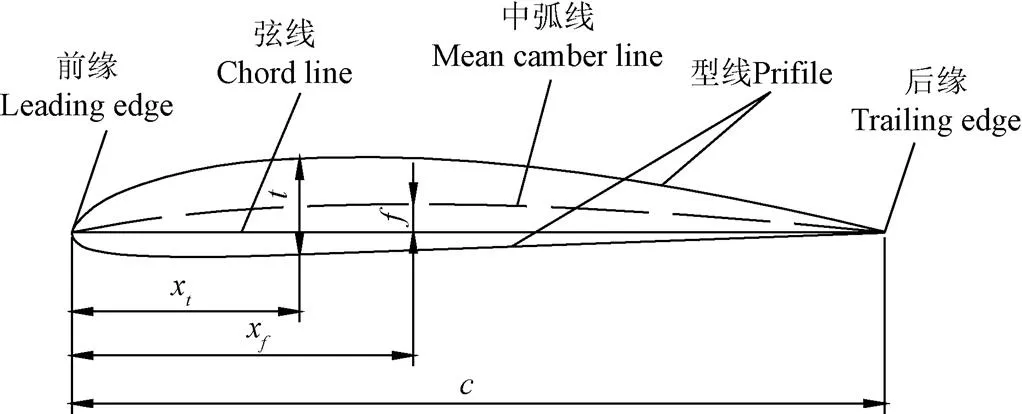
注:c表示翼型的弦长,mm,将c设定为1;t表示翼型的最大相对厚度;f表示翼型的最大相对弯度;xt表示翼型最大厚度相对弦长的位置;xf表示翼型最大弯度相对弦长的位置。
2 双椭圆弧型中弧线函数的构造
2.1 双椭圆弧型中弧线函数的求解
采用顶点重合的2个椭圆上截得的椭圆弧来构造翼型中弧线,具体方法如图2所示,为了方便描述,将翼型的弦长定义为1。
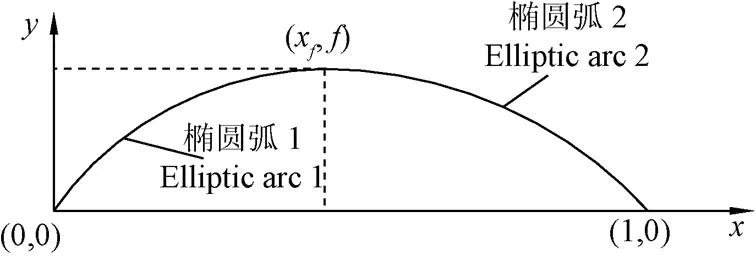
图2 双椭圆弧型中弧线示意图
图2中,点(0,0)与(1,0)分别为翼型的前缘点和后缘点,点(x,)为椭圆的顶点。中弧线型线方程y如式(1)所示。
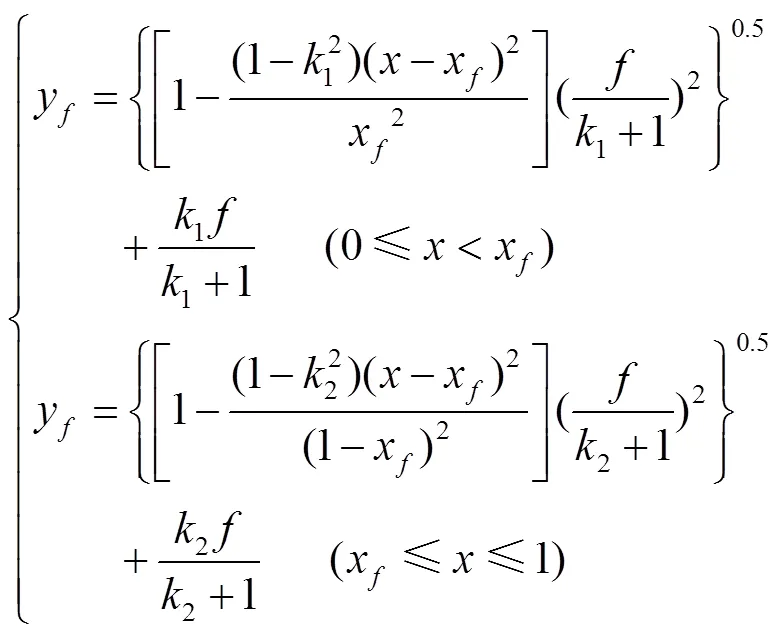
式中1为翼型中弧线前缘形状因子,−1<1≤0;2为翼型中弧线后缘形状因子,−1<2≤0。
2.2 中弧线形状因子k1和k2对中弧线形状的影响
当翼型中弧线的最大相对弯度和最大弯度相对位置x一定时,通过调整方程(1)中形状因子1和2的大小可以局部调整中弧线的形状。
为了研究形状因子1和2对中弧线形状的影响,在图3中给出了最大相对弯度=3.43%,最大弯度相对位置x=40%时,中弧线前缘形状因子1=−0.99,中弧线后缘形状因子2分别为0、−0.2、−0.5、−0.7、−0.99,和中弧线后缘形状因子2=−0.99,中弧线前缘形状因子1分别为0、−0.2、−0.5、−0.7、−0.99时的型线图。
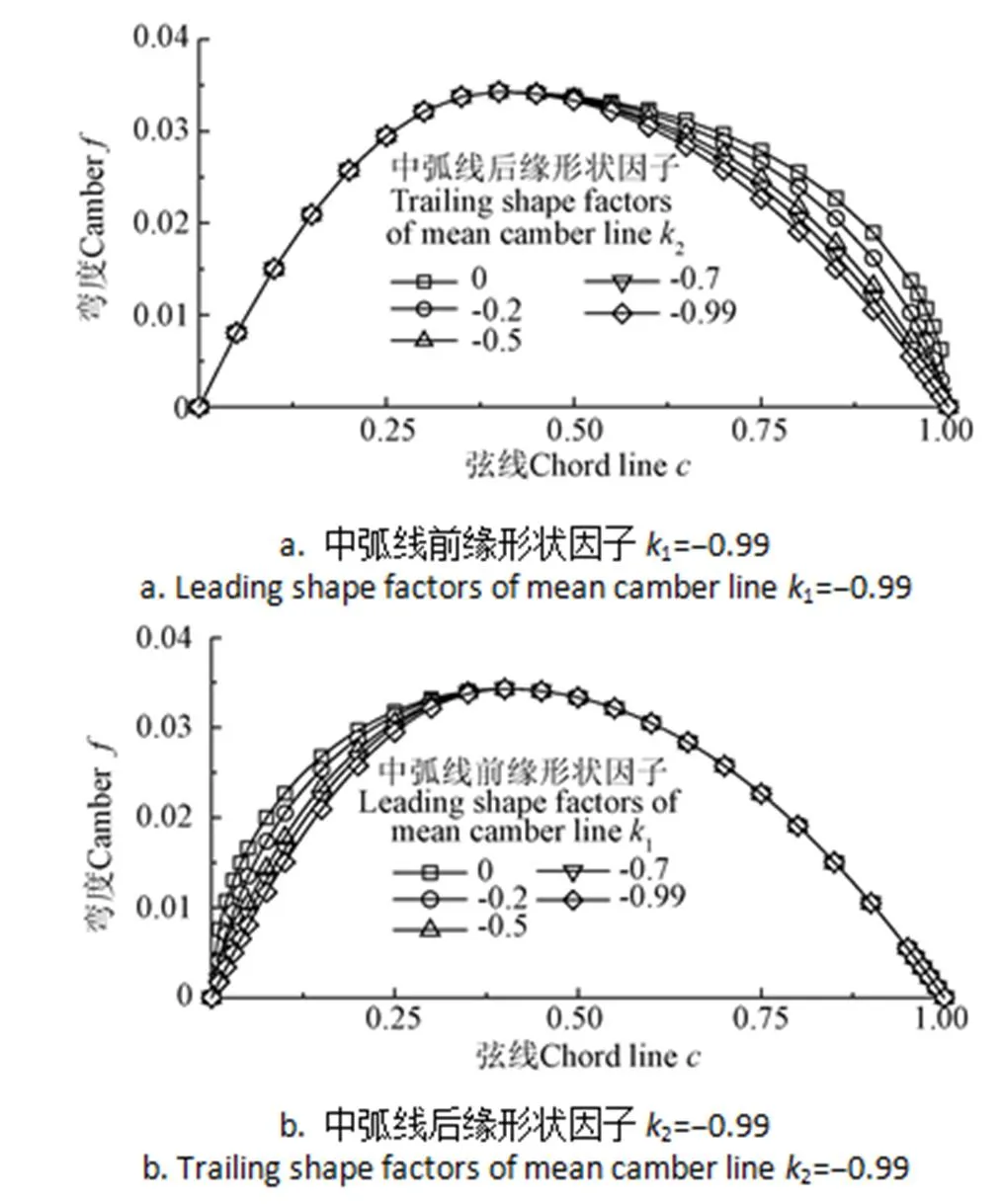
图3 不同k1和k2时的中弧线型线
由图3可知,当中弧线前缘形状因子一定而中弧线后缘形状因子变化时,前缘点至最大弯度处翼型中弧线型线保持不变,翼型后缘气流出口角随着中弧线后缘形状因子的增大而增大,当中弧线后缘形状因子2=0时,达到最大值。同样,当中弧线后缘形状因子一定而中弧线前缘形状因子变化时,最大弯度至后缘点翼型中弧线型线保持不变,翼型前缘气流出口角随着中弧线前缘形状因子的增大而增大,当中弧线前缘形状因子1=0时,达到最大值。结果表明,当中弧线的最大相对弯度和最大弯度相对位置一定时,随着形状因子1与2增大,翼型中弧线型线变得饱满,对应的气流角也逐渐增大,且形状因子1与2对型线的影响以最大弯度位置为分界点,相互独立。
3 系列翼型设计方法
翼型的型面函数可以表示为中弧线分布函数与厚度分布函数的叠加,如式(2)所示。
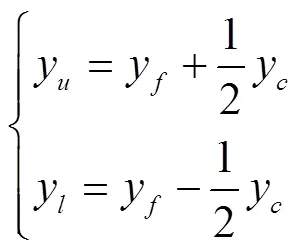
式中y、y分别表示翼型的上表面型面函数和下表面型面函数;y表示翼型的厚度分布函数。
式(2)中的中弧线分布函数y使用本文推导的式(1),厚度分布函数则选用现有翼型的厚度分布。为了能够调节翼型最大相对厚度的大小,引入了厚度比例因子,其表达式为
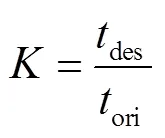
式中des表示设计翼型的最大相对厚度;ori表示原始翼型的最大相对厚度。
因此,可根据实际需要,通过调整厚度比例因子的大小得到理想的最大相对厚度。在式(2)的厚度项y前乘以系数,得到

式(4)给出了最终的翼型型面函数表达式。本文将该方法构造的翼型称之为DEA(double ellipse arcs)翼型。
4 结果与分析
选用Clark-Y翼型作为基础翼型,运用上述DEA翼型设计方法进行翼型设计。Clark-Y翼型的几何特征参数如下:最大相对厚度=11.71%,最大厚度相对位置x=28%,最大相对弯度=3.43%,最大弯度相对位置x=42%。在与Clark-Y翼型具有相同几何特征参数的条件下,取中弧线形状因子1=−0.8,2=−0.99,设计了一款DEA翼型,如图4所示。
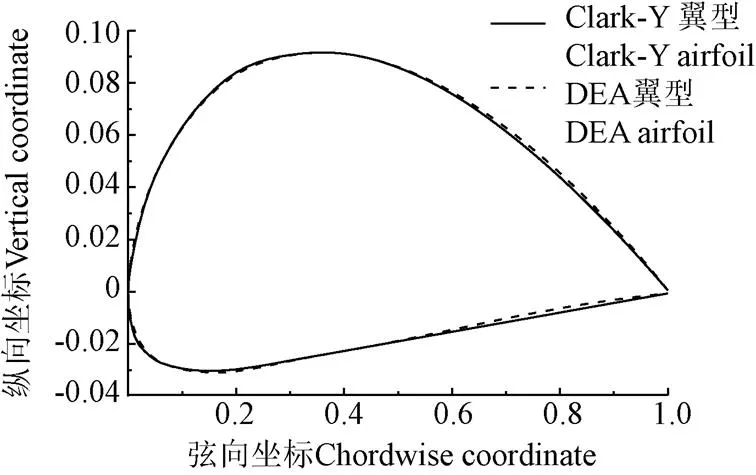
图4 Clark-Y翼型与DEA翼型的型线对比
Clark-Y翼型与DEA翼型的型线对比结果显示,两者的型线有较好的重合度,采用DEA翼型设计方法能够便捷的对现有翼型进行参数化。
为了研究几何特征参数对DEA翼型气动性能的影响,本文利用X-foil软件对翼型气动性能进行求解,取雷诺数=1.0×105。
4.1 最大相对弯度f对DEA翼型气动性能的影响
在最大相对厚度=11.71%、最大厚度相对位置x=28%和最大弯度相对位置x=42%的情况下,取中弧线形状因子1=−0.8,2=−0.99,分别设计了最大相对弯度为3.42%、4%、5%、6%时的翼型,气动性能计算结果如图5所示。
由图5可看出,在最大相对厚度、最大厚度相对位置和最大弯度相对位置相同的情况下,基础翼型Clark-Y与最大相对弯度=3.43%时的DEA翼型的性能曲线有较高的重合度,这里进一步验证了用DEA翼型参数化设计方法设计翼型的可靠性。当只改变最大相对弯度时,翼型的升力系数曲线在小攻角范围内基本保持平行,在同一攻角下,随着最大相对弯度的增大,升力系数也随之增大。此外,随着最大相对弯度的增大,翼型的升阻比曲线也发生了变化,当最大相对弯度=6%时,在0°、6°和12°攻角处,翼型的升阻比相对于Clark-Y翼型分别提高了6.88%、1.59%和24.49%。研究表明,在翼型厚度、最大厚度位置和最大弯度位置不变的情况下,增大相对弯度,可以提高DEA翼型的升力系数,同时使翼型的升阻特性得到一定的改善。
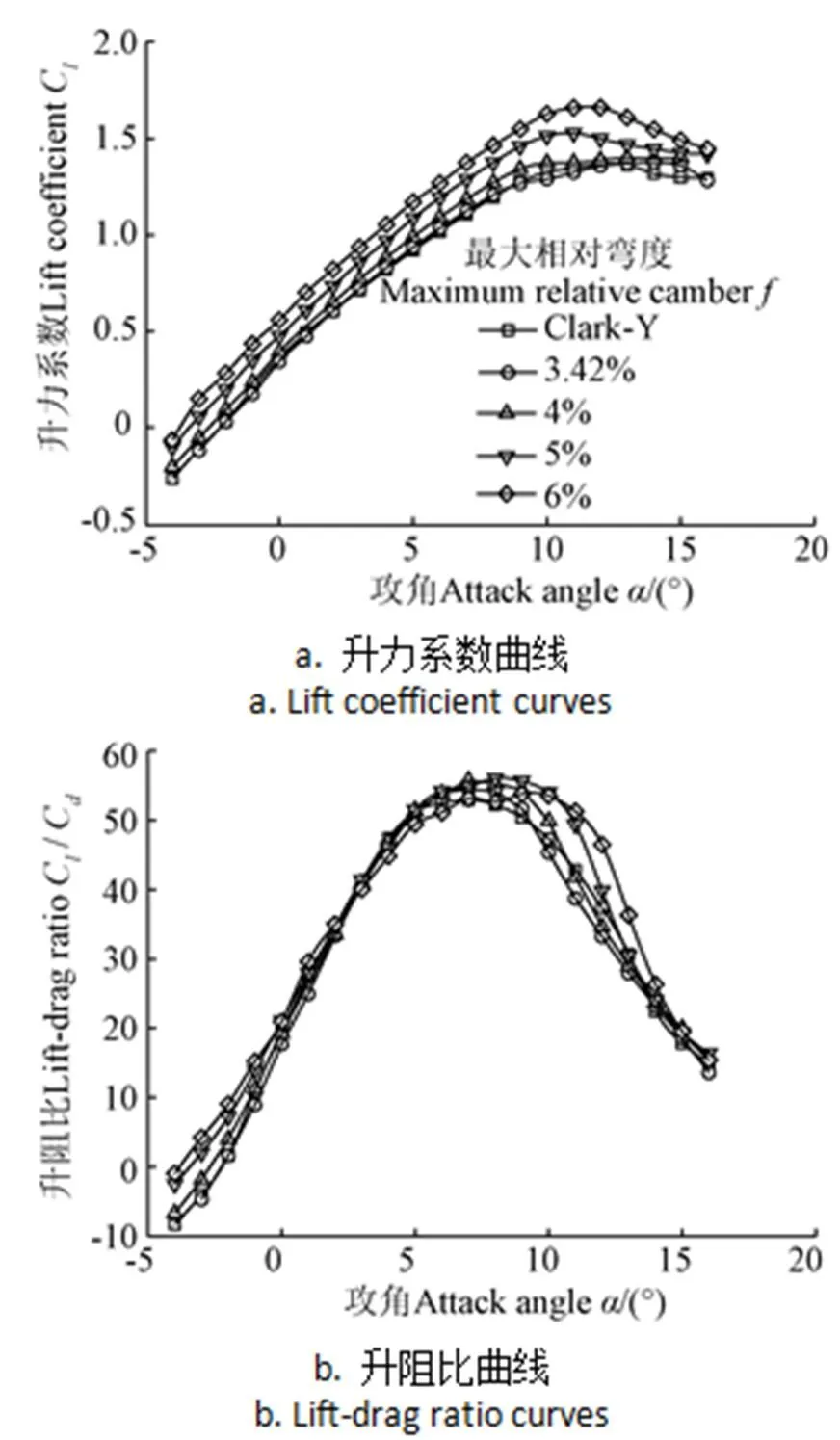
注:表示翼型攻角,(º);Cl表示翼型的升力系数;Cd表示翼型的阻力系数;Cl/Cd表示翼型的升阻比。
4.2 最大弯度相对位置xf对DEA翼型气动性能的影响
为了研究最大弯度相对位置x对DEA翼型气动特性的影响,在最大相对厚度=11.71%、最大厚度相对位置x=28%和最大相对弯度=3.43%的条件下,取中弧线形状因子1=−0.8,2=−0.99,分别设计了最大弯度相对位置x为25%、42%、50%、60%时的翼型,并对其气动性能进行了计算,计算结果如图6所示。
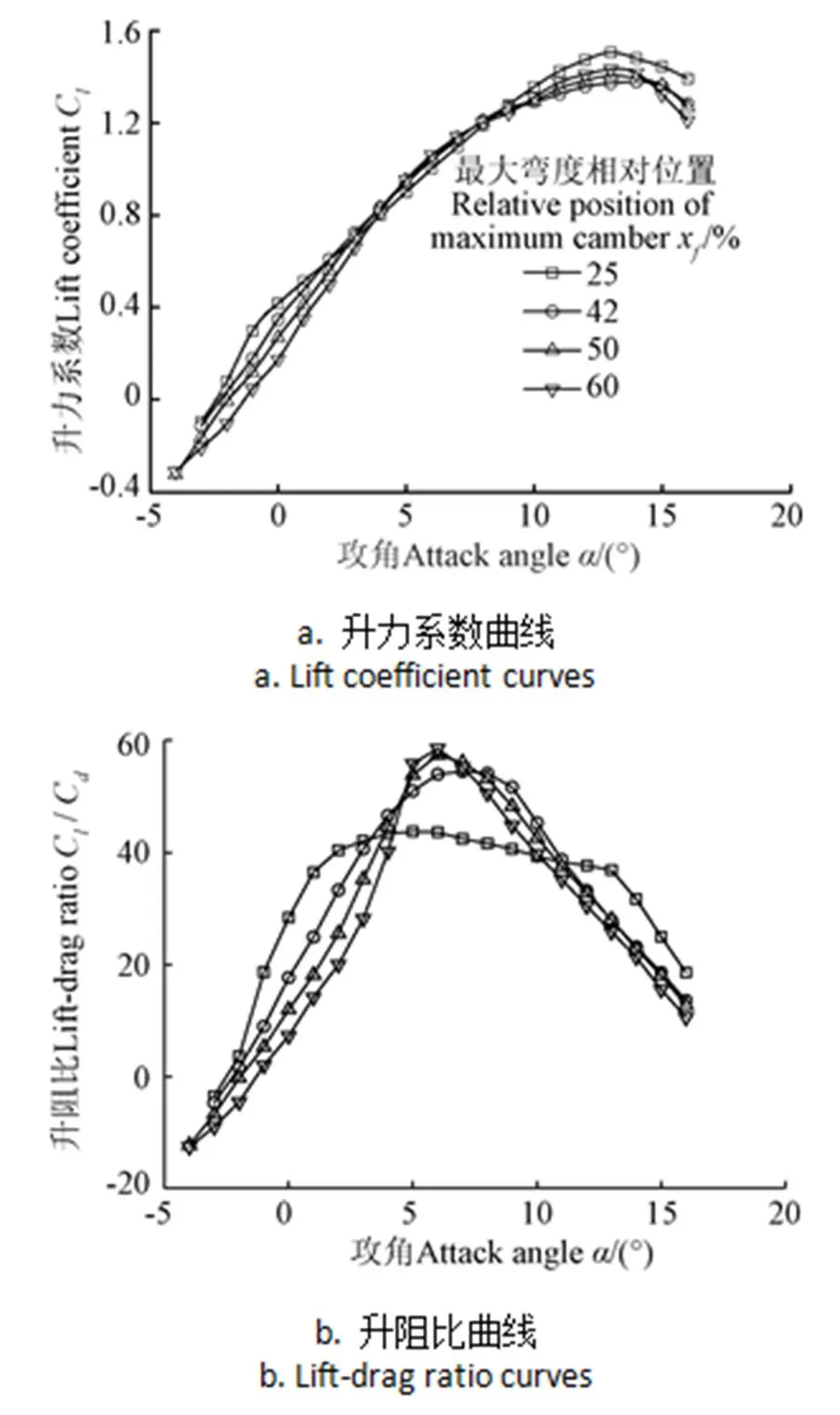
图6 不同xf下的DEA翼型气动性能曲线
4.3 最大相对厚度t对DEA翼型气动性能的影响
由薄翼理论可知,对于理想不可压缩流体的翼型绕流,如果气流绕翼型的迎角、翼型厚度、翼型弯度都很小,则绕流场是一个小扰动的势流场。这时,翼面上的边界条件和压强系数可以线性化为厚度、弯度、迎角三者影响的叠加。因此翼型的厚度对气动性能也起到至关重要的影响。图7中给出了最大弯度相对位置x=25%、最大厚度相对位置x=28%、最大相对弯度=3.43%,最大相对厚度分别为6%、8%、10%和11.71%时的DEA翼型气动特性曲线,中弧线形状因子取1=−0.8,2=−0.99。
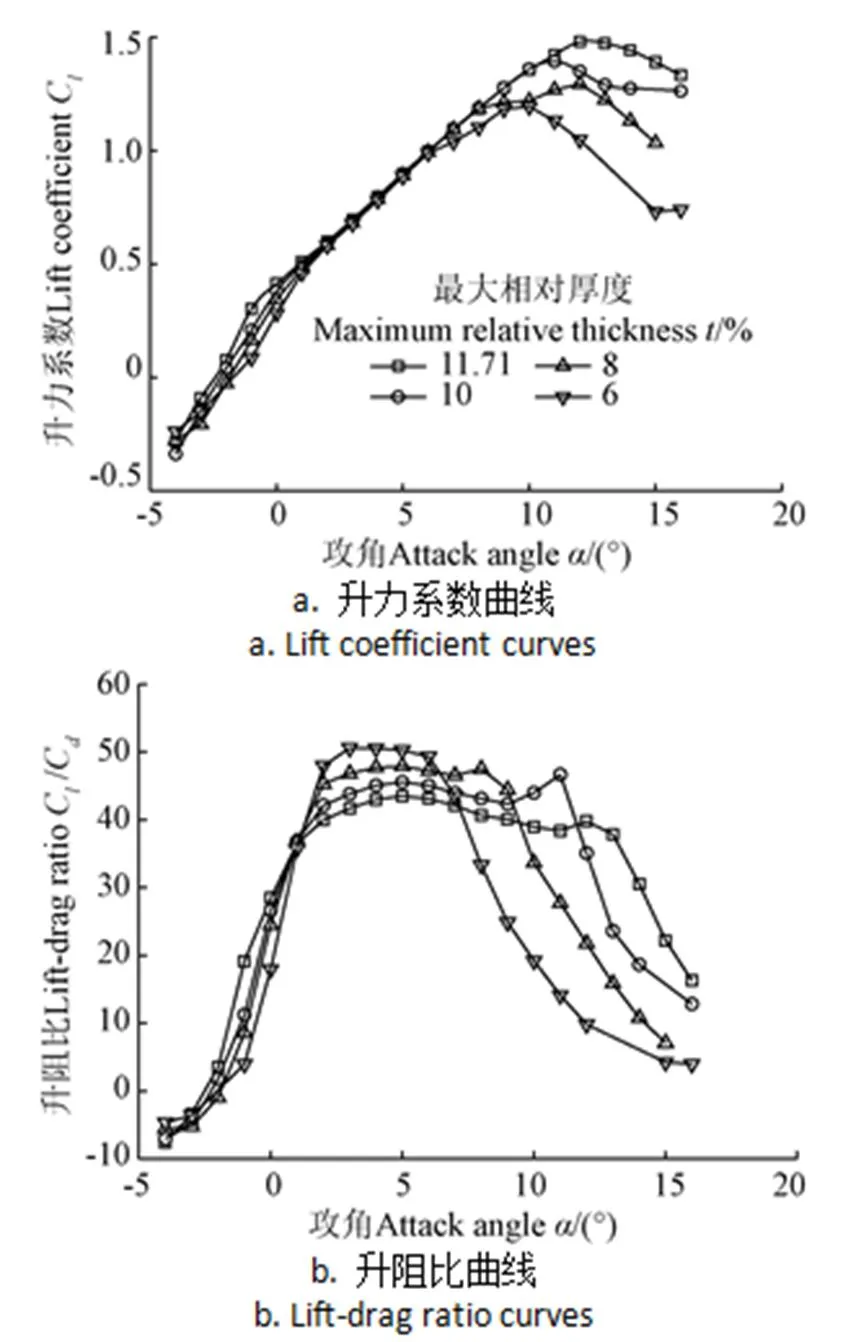
图7 不同t下的DEA翼型气动性能曲线
4.4 中弧线形状因子k1与k2对DEA翼型气动性能的影响
为了研究中弧线形状因子1和2对DEA翼型气动特性的影响,分别设计了最大相对厚度=11.71%、最大弯度相对位置x=42%、最大厚度相对位置x=28%、最大相对弯度=3.43%时,中弧线形状因子1=−0.2、−0.5、−0.7、−0.99,2=−0.99和1=−0.99,2=−0.2、−0.5、−0.7、−0.99的翼型,性能计算结果如图8和图9所示。
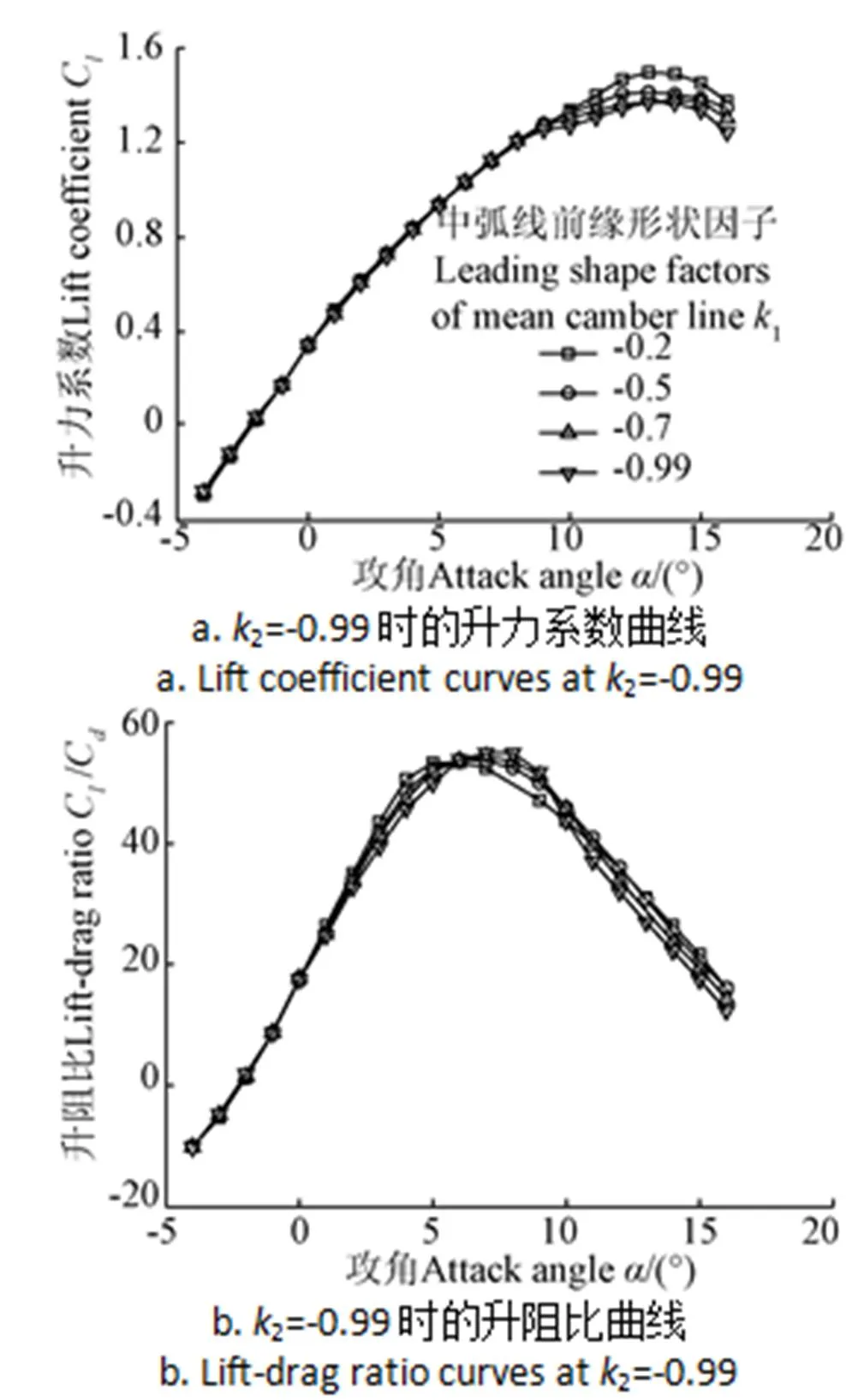
图8 不同k1下的DEA翼型气动性能曲线
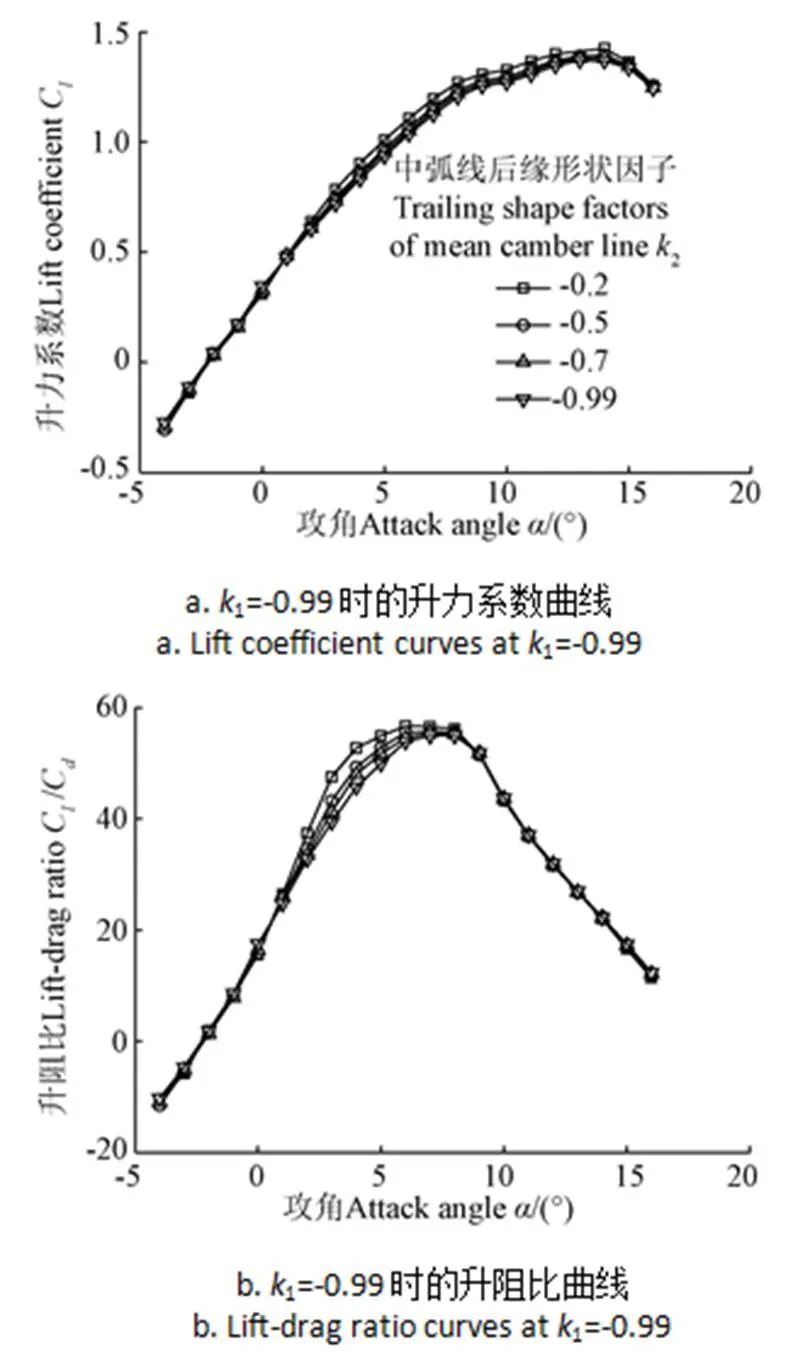
图9 不同k2下的DEA翼型气动性能曲线
5 结 论
1)采用两段椭圆弧来构造翼型中弧线,并推导了中弧线方程式,该方程通过改变最大弯度和最大弯度相对位置对中弧线形状进行控制,并由翼型中弧线形状因子实现局部微调。用该方法构造的中弧线光滑连续,且不存在拐点。
2)选用现有翼型的厚度分布,与中弧线分布函数进行叠加,并引入厚度比例因子来实现对厚度的控制,最终得到了一种基于双椭圆弧中弧线的翼型设计方法,本文将该方法构造的翼型称之为DEA(double ellipse arcs)翼型。
3)选用Clark-Y翼型作为基础翼型,设计了多款DEA翼型,并利用X-foil软件对翼型气动性能进行求解,分别研究了最大相对弯度、最大弯度相对位置、最大相对厚度,以及翼型中弧线的形状因子对翼型气动性能的影响。研究表明:增加最大相对弯度,可以提高翼型的升力系数,同时使翼型的升阻特性得到一定的改善;最大弯度位置前移,可以提高翼型在小攻角下的升力系数,同时增加翼型高效升阻比的攻角区间,但最优升阻比会逐渐减小;增加最大相对厚度可以提高翼型的最大升力系数,以及增大失速攻角,同时,高效升阻比的攻角区间也随着翼型厚度的增大而增加,但最优升阻比会逐渐减小;中弧线形状因子对翼型气动性能的影响较小。
依据上述参数的调整变化原则,可设计出新的翼型或者对原翼型进行修型以满足目标任务的需要。
[1] Mojtaba Tahani, Ghazale Kavari, Mehran Masdari, et al. Aerodynamic design of horizontal axis wind turbine with innovative local linearization of chord and twist distributions[J]. Energy, 2017, 131: 78-91.
[2] 项松,王吉,张利国,等. 一种高效率螺旋桨设计方法[J]. 航空动力学报,2015,30(1):136-141.
Xiang Song, Wang Ji, Zhang Liguo, et al. A design method for high efficiency propeller[J]. Journal of Aerospace Power, 2015, 30(1): 136-141. (in Chinese with English abstract)
[3] 沙毅,侯丽艳. 叶片厚度对轴流泵性能影响及内部流场分析[J]. 农业工程学报,2012,28(18):75-81.
Sha Yi, Hou Liyan. Effects of blade thickness on performance of axial flow pump and analysis of internal flow field[J]. Transactions of the Chinese Society of Agricultural Engineering (Transactions of the CSAE), 2012, 28(18): 75-81. (in Chinese with English abstract)
[4] 汪泉,陈进,王君,等. 基于连续攻角的风力机翼型整体气动性能提高的优化设计[J]. 机械工程学报,2017,53(13):143-149.
Wang Quan, Chen Jin, Wang Jun, et al. Wind turbine airfoil optimal design with high whole aerodynamic performance considering continuous angle of attack[J]. Journal of Mechanical Engineering, 2017, 53(13): 143—149. (in Chinese with English abstract)
[5] 徐浩然,杨华,刘超. 尾缘加厚的DU系列翼型气动性能数值分析[J]. 农业工程学报,2014,30(17):101-108.
Xu Haoran, Yang Hua, Liu Chao. Numerical value analysis on aerodynamic performance of DU series airfoils with thickened trailing edge[J]. Transactions of the Chinese Society of Agricultural Engineering (Transactions of the CSAE), 2014, 30(17): 101—108. (in Chinese with English abstract)
[6] Srilatha K R, Dwarakanath G S. Design of a natural laminar flow airfoil for a light aircraft[J]. Journal of Aircraft, 1990, 27(11): 966-968.
[7] 王骥月,丛茜,梁宁,等. 基于海鸥翼型的小型风力机叶片仿生设计与试验[J]. 农业工程学报,2015,31(10):72-77.
Wang Jiyue, Cong Qian, Liang Ning, et al. Bionic design and test of small-sized wind turbine blade based on seagull airfoil[J]. Transactions of the Chinese Society of Agricultural Engineering (Transactions of the CSAE), 2015, 31(10): 72—77. (in Chinese with English abstract)
[8] Green B E. An Approach to the Constrained Design of Natural Laminar flow Airfoils[M]. NASA Langley Technical Report Server, 1997.
[9] 严敬,刘小兵,周绪成,等. 基于奇点分布法的轴流泵叶片翼型设计与计算[J]. 农业工程学报,2016,32(7):100-105.
Yan Jing, Liu Xiaobing, Zhou Xucheng, et al. Design and calculation of airfoil profile of blade in axial flow pump based on singularity approach[J]. Transactions of the Chinese Society of Agricultural Engineering (Transactions of the CSAE), 2016, 32(7): 100-105. (in Chinese with English abstract)
[10] 龙腾,刘莉,孟令涛,等. 基于代理模型的翼型多目标集成优化设计[J]. 系统仿真学报,2010,22(7):1604-1608.
Long Teng, Liu Li, Meng Lingtao, et al. Multi-objective integrated optimization of airfoil based on surrogate model[J]. Journal of System Simulation, 2010, 22(7): 1604-1608. (in Chinese with English abstract)
[11] Lee J D, Jameson A. Natural-laminar flow airfoil and wing design by adjoint method and automatic transition prediction [C]// 47th AIAA Aerospace Sciences Meeting Including the New Horizons Forum and Aerospace Exposition. Orlando, Florida, 2009.
[12] Youngren H. Multi-Point design and optimization of an natural laminar flow airfoil for a mission adaptive compliant wing[C]// AIAA Aerospace Sciences Meeting and Exhibit. 2008:485601-485605(5).
[13] Driver J, Zingg D W. Optimized natural-laminar flow airfoils, AIAA-2006-247[R]. Toronto: American Institute of Aeronautics and Astronautics, 2006.
[14] Ashok G, Michael S S. Low speed NLF airfoils: Case study in inverse airfoil design[J]. Journal of Aircraft, 2001, 38(2): 57-63.
[15] 朱国俊,冯建军,郭鹏程,等. 基于径向基神经网络-遗传算法的海流能水轮机叶片翼型优化[J]. 农业工程学报,2014,30(8):65-73.
Zhu Guojun, Feng Jianjun, Guo Pengcheng, et al. Optimization of hydrofoil for marine current turbine based on radial basis function neural network and genetic algorithm[J]. Transactions of the Chinese Society of Agricultural Engineering (Transactions of the CSAE), 2014, 30(8): 65-73. (in Chinese with English abstract)
[16] Liang Xiao, Meng Guanglei, Tong Shengxi, et al. Rapid design and optimization of airfoil based on improved genetic algorithm[J]. Acta Aerodynamica Sinica, 2016, 31(6): 803-812.
[17] 王迅,蔡晋生,屈崑,等. 基于改进CST参数化方法和转捩模型的翼型优化设计[J]. 航空学报,2015,36(2):449-461.
Wang Xun, Cai Jinsheng, Qu Kun, et al. Airfoil optimization based on improved CST parametric method and transition model[J]. Acta Aeronautica et Astronautica Sinica, 2015, 36(2): 449-461. (in Chinese with English abstract)
[18] 姜海波,赵云鹏. 基于中弧线—厚度函数的翼型形状解析构造法[J]. 图学学报,2013,34(1):50-54.
Jiang Haibo, Zhao Yunpeng. Analytic expression method of airfoil profile shape based on a mean camber and thickness function[J]. Journal of Graphics, 2013, 34(1): 50-54. (in Chinese with English abstract)
[19] 姜海波,程忠庆,赵云鹏. 翼型型线的参数表达式探讨[J]. 机械设计与制造,2015,3:69-72.
Jiang Haibo, Cheng Zhongqing, Zhao Yunpeng. Study on parameter expressions of airfoil contour[J]. Machinery Design and Manufacture, 2015, 3: 69-72. (in Chinese with English abstract)
[20] Ray T, Tsai H M. Swarm algorithm for single and multiobjective airfoil design optimization[J]. AIAA Journal, 2004, 42(2): 366-373.
[21] David W Z, Timothy M L, Laslo D, et al. Improvements to a newton-krylov adjoint algorithm for aerodynamic optimization, AIAA-2005-4857[R]. Toronto: American Institute of Aeronautics and Astronautics, 2005.
[22] 刘周,朱自强,付鸿雁,等. 高升阻比翼型的设计[J]. 空气动力学学报,2004,22(4):410-415.
Liu Zhou,Zhu Ziqiang,Fu Hongyan,et al. Design of airfoil with high ratio of lift over drag[J]. Acta Aerodynamica Sinica, 2004, 22(4): 410-415. (in Chinese with English abstract)
[23] 陈进,张石强,Eecen P J,等. 风力机翼型参数化表达及收敛特性[J]. 机械工程学报,2010,46(10):132-138.
Chen Jin, Zhang Shiqiang, Eecen P J, et al. Parametric representation and convergence of wind turbine airfoils[J]. Journal of Mechanical Engineering, 2010, 46(10): 132-138. (in Chinese with English abstract)
[24] Mark D. XFOIL: An analysis and design system for low reynolds number airfoils[J]. Lecture Notes in Engineering, 1989, 54: 1-12.
[25] Bangga G, Hutomo G, Wiranegara R, et al. Numerical study on a single bladed vertical axis wind turbine under dynamic stall[J]. Journal of Mechanical Science and Technology, 2017, 31(1): 261-267.
[26] Ananda G K, Sukumar P P, Selig M S. Measured aerodynamic characteristics of wings at low Reynolds numbers[J]. Aerospace Science & Technology, 2015, 42: 392-406.
[27] Morgado J, Vizinho R, Silvestre M A R, et al. XFOIL vs CFD performance predictions for high lift low Reynolds number airfoils[J]. Aerospace Science and Technology, 2016, 52: 207-214.
[28] Ramanujam G, Özdemir H, Hoeijmakers H W M. Improving airfoil drag prediction[C]//Wind Energy Symposium, AIAA Scitech. 2016.
[29] Paulo A S F S, Léo D S, Taygoara F O, et al. Analysis of cavitation for the optimized design of hydrokinetic turbines using BEM[J]. Applied Energy, 2017, 185: 1281-1291.
[30] Ashok G, Michael S S. Low-speed natural-laminar-flow airfoils: case study in inverse airfoil design[J]. Journal of Aircraft, 2001, 38(1): 57-63.
[31] 邓磊,乔志德,杨旭东,等. 高升阻比自然层流翼型多点/多目标优化设计[J]. 空气动力学学报,2011,29(3):330-335.
Deng Lei, Qiao Zhide, Yang Xudong, et al. Multi-point/ objective optimization design of high lift-to-drag ratio for NLF airfoils[J]. Acta Aerodynamica Sinica, 2011, 29(3): 330-335. (in Chinese with English abstract)
Design method for series airfoil based on mean camber line consisting of double ellipse arcs
Zhang Sen, Xi Deke, Liu Zhibin, Chen Baofeng
Institute of Aeronautics, Northwestern Polytechnical University, Xi’an, ChinaShanxi Anrui Fan Electric Co., Ltd, Yuncheng, China
Airfoil, as a product of aviation technology, has been widely used in the design of fluid machinery products. The aerodynamic characteristics of airfoils are a key factor in determining the performance of fluid machinery. When the existing airfoils are not able to meet the engineering requirements, it is necessary to redesign or trim the original airfoils. In this research, 2 ellipse arcs were used to form the mean camber line of the airfoil, and the corresponding equation was deduced. This equation controls the shape of the mean camber line by changing the maximum camber and the relative position of maximum camber, and adjusts the local shape by changing the 2 shape factors of the mean camber line. The mean camber line constructed by this method is smooth and continuous, and there is no knee point. Then the thickness distribution of the existing airfoil was superposed with the distribution function of mean camber line, and a thickness scale factor was introduced to adjust the thickness distribution. Ultimately, the design method for a series of airfoils based on mean camber line of double ellipse arcs is achieved, which is called DEA (double ellipse arcs) airfoil. The airfoil profile function constructed by this method has definite physical meaning, simple and reliable, and it is easy to realize serialization. In order to study the influence of airfoil characteristic parameters on aerodynamic performance of the DEA airfoil, the Clark-Y airfoil was taken as the basic airfoil, and a number of DEA airfoils were designed using the thickness distribution of the Clark-Y airfoil. Then the aerodynamic characteristics of the designed airfoils were solved by the X-foil software to study the influence of the maximum camber, the relative position of the maximum camber, the maximum thickness and the shape factors of the mean camber line on the DEA airfoil aerodynamic performance. There are 5 characteristic parameters in all that influence the shape of the DEA airfoil. We selected one of the 5 characteristic parameters as variable and fixed the other 4 characteristic parameters to design different DEA airfoils. And the aerodynamic characteristics were achieved at Reynolds number of 1.0×105. The calculation results of the 4 DEA airfoils with different values of maximum camber show that the increase of the maximum camber can improve the lift coefficient and ameliorate the characteristics of the lift-drag ratio. The calculation results of the 4 DEA airfoils with different values of relative position of the maximum camber show that as the relative position of the maximum camber moves forward, the lift coefficient under small angles of attack is improved, and the range of efficient lift-drag ratio gets broadened. The calculation results of the 4 DEA airfoils with different values of maximum thickness show that the increase of the maximum thickness can increase the maximum lift coefficient and the stall angle. At the same time, with the increase of thickness, the range of efficient lift-drag ratio also gets broadened. The calculation results of the DEA airfoils with different shape factors of the mean camber line also were achieved. At small attack angle, the change of the leading shape factors of the mean camber line has little influence on lift coefficient. With the decrease of the leading shape factors of the mean camber line, the interval of efficient lift-drag ratio has a tendency to move to high attack angle range. With the decrease of the trailing shape factors of the mean camber line, the lift coefficient and lift-drag ratio decrease gradually. Moreover, the interval of efficient lift-drag ratio also decreases and the decrease is mainly at the range of small attack angle. According to the adjustment principle of the above parameters, a new airfoil can be designed or modified to meet the needs of the target task.
design; airfoils; numerical analysis; mean camber line; double ellipse arcs
10.11975/j.issn.1002-6819.2018.02.006
TB126/TB21
A
1002-6819(2018)-02-0040-07
2017-07-07
2017-12-12
国家自然科学基金(11172243);陕西省科技统筹创新工程计划(2011KTCQ01-02)
张 森,河南新乡人,博士生,研究方向为航空高科技军转民技术及流体机械设计。Email:sen96@mail.nwpu.edu.cn
席德科,教授,博士生导师,研究方向为风洞设计及流体机械设计。Email:xideke@nwpu.edu.cn
张 森,席德科,刘治斌,陈宝峰. 基于双椭圆弧型中弧线的系列翼型设计方法[J]. 农业工程学报,2018,34(2):40-46. doi:10.11975/j.issn.1002-6819.2018.02.006 http://www.tcsae.org
Zhang Sen, Xi Deke, Liu Zhibin, Chen Baofeng. Design method for series airfoil based on mean camber line consisting of double ellipse arcs[J]. Transactions of the Chinese Society of Agricultural Engineering (Transactions of the CSAE), 2018, 34(2): 40-46. (in Chinese with English abstract) doi:10.11975/j.issn.1002-6819.2018.02.006 http://www.tcsae.org
